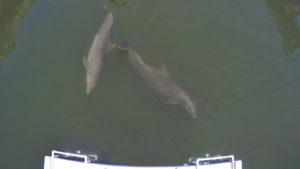Dolphins understand their partner’s role in cooperative tasks

A new study by researchers at The University of Western Australia and the United States-based Dolphin Research Center shows that bottlenose dolphins not only cooperate with each other, but can do so with precise behavioural coordination never before demonstrated in nonhuman animals.
Dr Stephanie King, from UWA’s Centre for Evolutionary Biology, said behaviours that looked like cooperation in the wild did not necessarily mean that animals understood cooperation.
“Cooperative behaviours are actually found throughout the animal kingdom,” Dr King said. “From small birds collectively dive-bombing a predator to drive it away, to ants teaming up to carry a large piece of food ”“ that’s not new.
“But the question is how they’re doing it. Are they simply acting individually in the same place and time, or do they actually understand that they need their partner, and actively coordinate with them?”
To find out, the researchers created a task in which pairs of dolphins had to swim across a lagoon and each press their own underwater button simultaneously (within a one-second time window), whether sent together or with a delay between partners of up to 20 seconds.
Dr Kelly Jaakkola, of the Dolphin Research Center in the Florida Keys, said the researchers wanted to find out whether the dolphin sent first would wait for the other dolphin before pressing its button and whether they could figure out a way to coordinate precisely enough to press at the same time.
The results of the study, published in Proceedings of the Royal Society B, showed that the dolphins not only waited for their partner, but also succeeded at the task with extreme precision, with the time between button presses in the latter trials averaging just 370 milliseconds.
Dr Jaakkola said this revealed that bottlenose dolphins understood how cooperation worked, and suggested that the behavioural synchronisation they showed in the wild could be a generalised cognitive ability that they could apply to a variety of situations.
In previous studies, animals’ understanding of cooperation has been explored primarily with a task in
which two animals must pull the ends of a rope in the same direction to succeed, she said.
“However, the less stringent timing requirement of that task creates a window of opportunity in which the animals could theoretically succeed by using a simpler behavioural strategy. For example, pull when a partner is there, rather than by jointly intended coordination. The tight timing requirement of the button press study closes that window.”
Dr King said the dolphins’ precise coordination task was inspired by wild dolphin behaviour.
“The behavioural simultaneous action we observe in wild dolphins can be remarkably precise, for example, the simultaneous action we observe in the coordinated displays of allied male dolphins is thought to actively promote cooperation,” she said.
“We wanted to test whether this was a skill they could apply to new situations. The next step will be to investigate whether dolphins use vocal signals to coordinate behaviour during cooperative situations,” Dr King said.
“This will further our understanding of the role that communication plays in facilitating cooperation in animal societies.”
The study was supported by grants from Jim and Marjorie Sanger and The Branco Weiss Fellowship.
Short URL: https://indiandownunder.com.au/?p=11673
